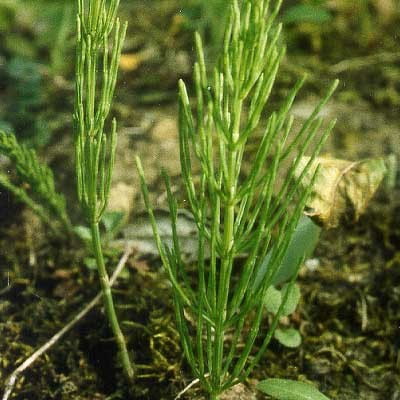Area
The plant is widespread and is found everywhere except in desert and semi-desert areas. The sagebrush plant grows mainly in stream banks, sandy meadows, among bushes, forests and arable lands.
Botanical description of the plant
Field squirrels - Squirrels - belong to the family Equisetaceae. Field horsetail is a perennial, spore-bearing plant. The rhizome is long and articulated, from which thin dark roots grow towards the ground, and 2 different stems grow above the ground. At the root there are tufts where reserve nutrients accumulate. The plant stem is spring and summer. Spring stems are yellowish or reddish in color, soft, 15–20 cm in height, forming spores. This stem grows in early spring. In its third part develops a spike consisting of spore leaves, arranged in a straight ring. The spore leaves are hexagonal, densely clinging to each other, attached to the stem by a thin band coming out of the center. Spore-shaped sporangia develop on the underside of the spore leaves. Spores appear inside the sporangia. Once the spores mature, the spike elongates, causing the spore leaves to separate, the sporangia to rupture, and the spores from them to scatter on the ground. Spores that fall to the ground, germinate and turn into a tumor, the gametophyte, the sexual offspring of the squirrel. Tumors are bisexual, unisexual, in one of which only the paternal genitalia antheridia develop, and in the second the maternal genitalia - archeology. The egg cell of the archaea becomes an embryo, from which a young lizard (asexual offspring) grows. In the spring the stem dries out after the spores have matured and shed their hair. Summer stems are green, hard, branched into balls, leafless, 50-60 cm tall, do not form spores. This stem grows in spring and dries up in autumn.

Medicinal properties
Drugs are used as a diuretic in circulatory failure, inflammation of the bladder and urinary tract disease. In addition, fenugreek is used in the treatment of some forms of silicic acid metabolism disorders of pulmonary tuberculosis, as well as as a hemostatic agent in uterine bleeding and hemorrhoids. The field rhubarb plant is not used in some musculoskeletal disorders of the kidneys (nephritis nephrosis and nephrozo-nephritis). Liquid extract, decoction, infusion. The product is also included in the diuretic tea-collection and edrenko collection.
Growing technology
Propagated by field rhizome root. The plant grows well in open, light soils. It is watered in moderation and, depending on the need, planted in moist soil. Resistant to disease, not demanding to fertilizers. It is planted as a root. The plant grows and develops rapidly. Lives up to 20 years.





